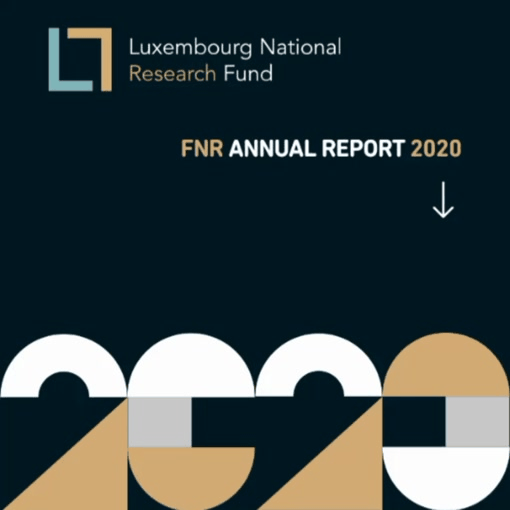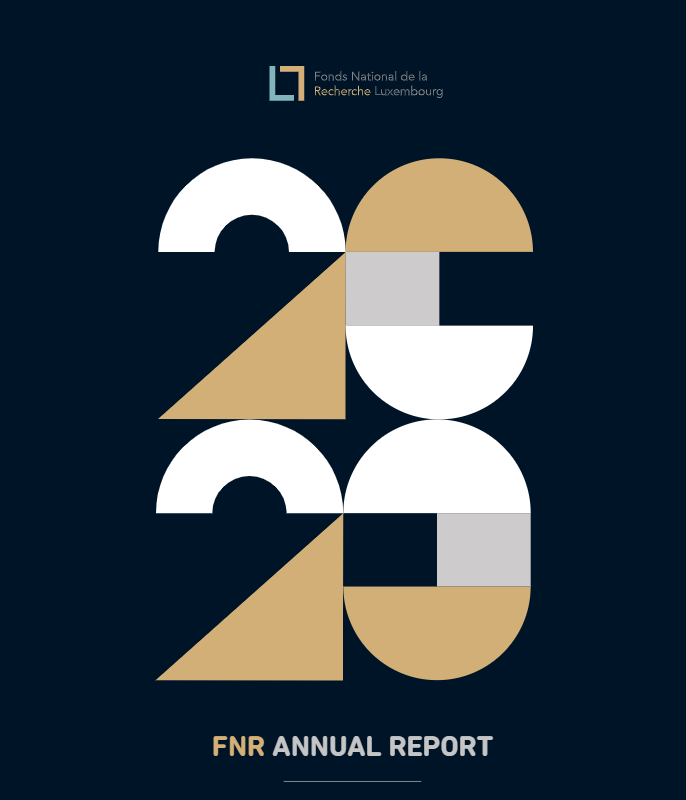The FNR has published its annual report for 2020, a year which was obviously marked by the COVID-19 crisis, but which also saw the funding of 299 research projects for a committed amount of 97.06 MEUR.
The increase in these two figures can be explained on the one hand by the rapid implementation of calls for projects launched within the framework of the activities of the Research Luxembourg Task Force, and on the other hand by the increase in the number of projects submitted in specific programmes (CORE, BRIDGES, Industrial Fellowships).

The FNR worked with lola – strategy&design on the design and development of the 2020 FNR Annual Report
Over one year after the start of the COVID-19 pandemic, society can finally see the light at the end of the tunnel. This severe global health crisis has shown the valuable contribution that science can make to society. In an unprecedented way, scientists worldwide have collaborated to understand the new coronavirus and develop new approaches to virus detection, epidemiological monitoring and vaccines.
The crisis was a defining moment for research in Luxembourg. All actors joined forces to use the combined expertise of Luxembourg science to tackle the pandemic. The large-scale testing initiative (LST), prevalence and stratification studies (CON-VINCE and Predi-COVID), epidemiological modelling and socio-economic impact assessment are just some of the activities carried out by the Research Luxembourg Task Force, which were partly co-financed by the FNR. It has been clearly demonstrated that public research institutions are now firmly anchored in Luxembourg society and that they generate impact.
“The Luxembourg National Research Fund has largely contributed to these efforts“, explains Marc Schiltz, Secretary–General of the FNR, “both from a financial point of view, where 7.5 MEUR have been mobilised, and through its very active involvement in the Research Luxembourg Task Force, where the FNR has coordinated several working groups.”
The COVID-19 crisis also showed how essential scientific communication is. “In these circumstances“, Marc Schiltz continues, “it has been very helpful that the FNR, over the years, has developed a wide range of scientific communication skills, as well as channels for scientific communication to the general public, which are considered reliable and trustworthy. The experience gained by the FNR over the years in dealing with journalists and policymakers has also been of great importance during this crisis. Over the past twelve months, science.lu has truly become a reference site for scientific communication around COVID-19. In addition, twelve detailed fact-checking articles were published in 2020.”
At the administrative level, the FNR learned to adapt all its work processes to a new situation in a short period of time. Flexible measures were introduced as early as the end of March 2020, to help FNR-funded researchers cope with the difficult situation where many ongoing research projects had to be interrupted due to closures or travel restrictions.
However, 2020 was also the first year in which the FNR implemented the newly defined national research priorities in its funding instruments. In the main project funding programme, CORE, there was an impressive increase (almost 30%) in the number of applications submitted compared to previous years. This shows the vitality of our research system and the relevance of research priorities.
Marc Schiltz concludes: “Every crisis offers its share of opportunities. Learning from this particular period will help us at the FNR to further improve our work and to remain one of the key institutions in the research ecosystem. This ecosystem, which is evolving in an ever-changing environment, needs players who are able and willing to adapt. The FNR has proven to be such a player and will continue, as it has done over the past two decades, to ensure and promote quality research and build bridges to society.“
97.06 million for research projects selected according to the criteria of excellence
In 2020, 191 research projects, 54 science communication projects – for communication between scientists as well as for exchange with society – and 54 doctoral and post-doctoral fellowships were selected for funding6.
1397 international expert assessments were carried out as part of the evaluation and selection process. Of the 781 eligible proposals, 299 were selected for funding, representing an overall success rate of 38.28%. To fund all the projects selected in 2020, the FNR committed €97.06 million.

Project : Hybrid Perovskite Surfaces (HYPS)
Researcher : Alex Redinger (FNR ATTRACT Fellow)
Institution : University of Luxembourg
Budget committed by the FNR : 552.000€
Solar cells are very important for the production of environmentally friendly electricity on large scales. In order to produce better solar cells, which can convert light more efficiently into electrical power, new materials need to be developed and improved. Hybrid perovskites are an emerging class of materials that exhibit excellent optical and electrical properties that makes them very suitable for solar cells. A solar cell device consists of many different materials that are stacked on top of each other. The final device performance will be determined by a complex interplay between all these layers.
Consequently, the surface and interfaces of the materials play a crucial role in the development of high efficiency devices and need to be understood as good as possible. Within this project the fundamental surface properties of several types of perovskites will be investigated with surface sensitive techniques such as Photoelectron Spectroscopy (PES) and Scanning Probe Microscopy (SPM). The team around Alex Redinger will combine both techniques to develop a consistent model of the electronic structure of the surface. It will carry out measurements at temperatures between 100K and 350K in order to better understand the effect of mobile ions in the material. Furthermore, the researchers will develop novel synthesis routines based on vacuum evaporation where they will develop a dedicated alkali doping strategy to reduce the ionic mobility in the perovskite thin films.
Project: FinTech/RegTech in Space for Trustful Autonomous Robotic Interaction (FiReSpARX)
Researcher : Gilbert Fridgen (Paypal FNR PEARL Chair)
Institution : SnT / University of Luxembourg
Budget committed by the FNR : 852.000€
In just a few years, mankind will start to exploit resources in space. In these missions, not only space agencies will be involved, but also private companies. Companies and space agencies will send robots to celestial bodies, most likely at first to the moon. To avoid duplicate work, it would be very efficient for these robots to cooperate, e.g. by providing each other with data or by offering re-usable services, e.g. telecommunication to earth. As in space unexpected can happen frequently and as decisions on earth might be too slow, robots need to be able to make autonomous economic decisions.
Robots would, e.g., bargain on the value of a certain service. To do this, robots need to be equipped with specific artificial intelligence and distributed ledger technology. Distributed ledger technology is a generic term for Blockchain that is also known from cryptocurrencies like Bitcoin. The distributed ledger also contains “smart contracts”, that describe the laws of cooperation between the robots. In the FiReSpARX project, the researchers will develop distributed ledger technology and artificial intelligence for such cooperating space robots and integrate everything into a well-tested prototype.
Project : Glioma Longitudinal AnalySiS in Luxembourg (GLASS-LUX): ex vivo and in vivo Functional Profiling of Recurrent Gliomas (GLASS-LUX)
Researcher : Simone Niclou
Institution : Luxembourg Institute of Health (LIH)
Budget committed by the FNR: 852.000€ (co-financed by the Fondation Cancer)
This project aims to offer novel treatment options for glioma patients after the standard of care has been unsuccessful. Gliomas are the most frequent brain tumours in the adult population and have largely a poor prognosis. The current treatment protocol often includes surgery, radio- and chemotherapy, nevertheless a large proportion of gliomas will recur after a variable period of time. At recurrence, the tumours have evolved and display molecular and functional differences compared to the original tumour. Therefore it is important to study not only the primary tumour tissue, but also the recurring tumour.
In this project the researchers will compare the drug response of primary and recurrent gliomas, using a large panel of clinically approved drugs. This high throughput screen performed on patient-derived tumour tissue, will provide information on treatment efficacy for the tumour of a given patient at a specific point in time. A key aspect of this project is that the researchers will be able to validate their findings in unique patient-derived cancer models in the lab, in support of the clinical application of this this personalized approach to become applicable in the clinical setting.
Project : Oil spill and VEssels monitoring from multi-tempoRal Satellite Earth observAtion dataSets (OVERSEAS)
Researcher : Ramona Pelich
Institution : Luxembourg Institute of Science and Technology (LIST)
Budget committed by the FNR: 547.000€
For maritime safety responders, having access to a massive amount of satellite data has not intrinsically an operational value, but this data can become relevant if they are rapidly translated into maps that can be used to manage marine pollution. There are several algorithms available, which are now mature and ready for operational implementation for oil spill monitoring and vessel detection services. However, there are several limitations in satellite–based oil spill monitoring such as discriminating against various oil slick look-alike features, e.g. wind speed and algae bloom affecting Synthetic Aperture Radar (SAR) imagery. OVERSEAS aims to propose innovative automatic methodologies that employ multi-temporal and multi-sensor collections of remote sensing data and ancillary information in order to offer new solutions for improving the monitoring of oil spills for many areas around the world and identifying the potential sources responsible for oil discharges.
Project : Digital Media as Language And Literacy Learning Spaces in Multilingual Families (DigiFam)
Researcher : Maria Obojska
Institution : Université du Luxembourg
Budget committed by the FNR: 433.000€
Because of globalisation and as a result of migration, many families nowadays need to find ways to learn new languages and maintain their mother tongues. Many of migrant families use digital media to support the learning of languages, as well as literacy skills, such as reading and writing. However, at the moment, we do not know in detail how this is accomplished and what digital media they use. The recent COVID-19 outbreak showed that it is very important to understand how digital media are and can be used for learning. In the project DigiFam the researchers will investigate how adults and children in migrant families in Luxembourg make use of various digital media to learn languages and literacy. Their findings will be useful for migrant families for making informed decisions about the use of particular media for language and literacy learning. The policymakers and teachers will also be able to make use of the findings to draw on children’s resources and effectively use digital tools in language and literacy learning at schools, this way preparing the children for the demands of modern societies.
